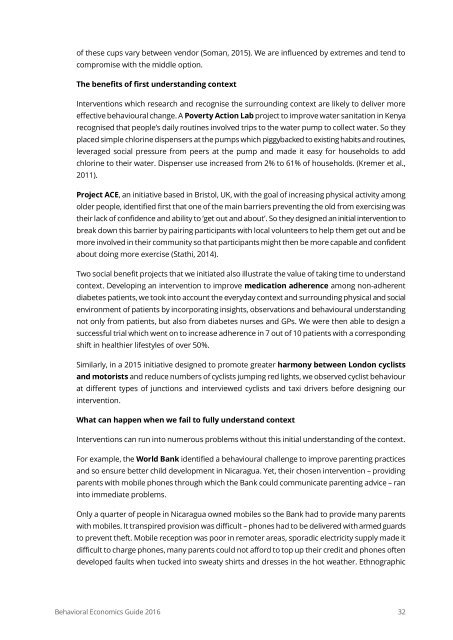THE BEHAVIORAL ECONOMICS GUIDE 2016
BEGuide2016
BEGuide2016
Create successful ePaper yourself
Turn your PDF publications into a flip-book with our unique Google optimized e-Paper software.
of these cups vary between vendor (Soman, 2015). We are influenced by extremes and tend to<br />
compromise with the middle option.<br />
The benefits of first understanding context<br />
Interventions which research and recognise the surrounding context are likely to deliver more<br />
effective behavioural change. A Poverty Action Lab project to improve water sanitation in Kenya<br />
recognised that people’s daily routines involved trips to the water pump to collect water. So they<br />
placed simple chlorine dispensers at the pumps which piggybacked to existing habits and routines,<br />
leveraged social pressure from peers at the pump and made it easy for households to add<br />
chlorine to their water. Dispenser use increased from 2% to 61% of households. (Kremer et al.,<br />
2011).<br />
Project ACE, an initiative based in Bristol, UK, with the goal of increasing physical activity among<br />
older people, identified first that one of the main barriers preventing the old from exercising was<br />
their lack of confidence and ability to ‘get out and about’. So they designed an initial intervention to<br />
break down this barrier by pairing participants with local volunteers to help them get out and be<br />
more involved in their community so that participants might then be more capable and confident<br />
about doing more exercise (Stathi, 2014).<br />
Two social benefit projects that we initiated also illustrate the value of taking time to understand<br />
context. Developing an intervention to improve medication adherence among non-adherent<br />
diabetes patients, we took into account the everyday context and surrounding physical and social<br />
environment of patients by incorporating insights, observations and behavioural understanding<br />
not only from patients, but also from diabetes nurses and GPs. We were then able to design a<br />
successful trial which went on to increase adherence in 7 out of 10 patients with a corresponding<br />
shift in healthier lifestyles of over 50%.<br />
Similarly, in a 2015 initiative designed to promote greater harmony between London cyclists<br />
and motorists and reduce numbers of cyclists jumping red lights, we observed cyclist behaviour<br />
at different types of junctions and interviewed cyclists and taxi drivers before designing our<br />
intervention.<br />
What can happen when we fail to fully understand context<br />
Interventions can run into numerous problems without this initial understanding of the context.<br />
For example, the World Bank identified a behavioural challenge to improve parenting practices<br />
and so ensure better child development in Nicaragua. Yet, their chosen intervention – providing<br />
parents with mobile phones through which the Bank could communicate parenting advice – ran<br />
into immediate problems.<br />
Only a quarter of people in Nicaragua owned mobiles so the Bank had to provide many parents<br />
with mobiles. It transpired provision was difficult – phones had to be delivered with armed guards<br />
to prevent theft. Mobile reception was poor in remoter areas, sporadic electricity supply made it<br />
difficult to charge phones, many parents could not afford to top up their credit and phones often<br />
developed faults when tucked into sweaty shirts and dresses in the hot weather. Ethnographic<br />
Behavioral Economics Guide <strong>2016</strong> 32


